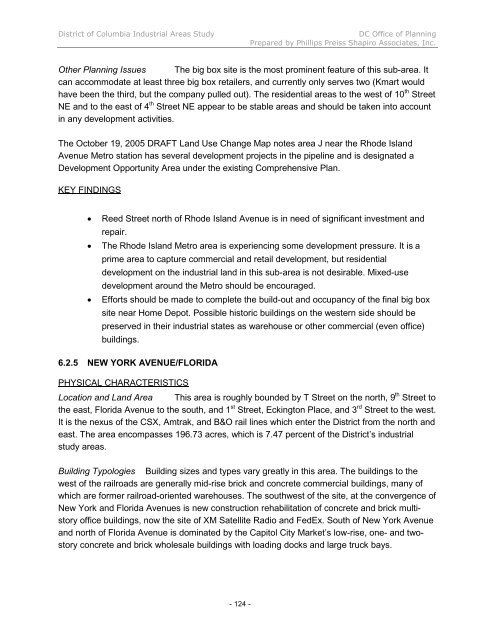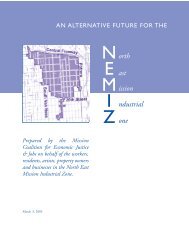INDUSTRIAL LAND IN A POST-INDUSTRIAL CITY District of ...
INDUSTRIAL LAND IN A POST-INDUSTRIAL CITY District of ...
INDUSTRIAL LAND IN A POST-INDUSTRIAL CITY District of ...
Create successful ePaper yourself
Turn your PDF publications into a flip-book with our unique Google optimized e-Paper software.
<strong>District</strong> <strong>of</strong> Columbia Industrial Areas Study DC Office <strong>of</strong> Planning<br />
Prepared by Phillips Preiss Shapiro Associates, Inc.<br />
Other Planning Issues The big box site is the most prominent feature <strong>of</strong> this sub-area. It<br />
can accommodate at least three big box retailers, and currently only serves two (Kmart would<br />
have been the third, but the company pulled out). The residential areas to the west <strong>of</strong> 10 th Street<br />
NE and to the east <strong>of</strong> 4 th Street NE appear to be stable areas and should be taken into account<br />
in any development activities.<br />
The October 19, 2005 DRAFT Land Use Change Map notes area J near the Rhode Island<br />
Avenue Metro station has several development projects in the pipeline and is designated a<br />
Development Opportunity Area under the existing Comprehensive Plan.<br />
KEY F<strong>IN</strong>D<strong>IN</strong>GS<br />
Reed Street north <strong>of</strong> Rhode Island Avenue is in need <strong>of</strong> significant investment and<br />
repair.<br />
The Rhode Island Metro area is experiencing some development pressure. It is a<br />
prime area to capture commercial and retail development, but residential<br />
development on the industrial land in this sub-area is not desirable. Mixed-use<br />
development around the Metro should be encouraged.<br />
Efforts should be made to complete the build-out and occupancy <strong>of</strong> the final big box<br />
site near Home Depot. Possible historic buildings on the western side should be<br />
preserved in their industrial states as warehouse or other commercial (even <strong>of</strong>fice)<br />
buildings.<br />
6.2.5 NEW YORK AVENUE/FLORIDA<br />
PHYSICAL CHARACTERISTICS<br />
Location and Land Area This area is roughly bounded by T Street on the north, 9 th Street to<br />
the east, Florida Avenue to the south, and 1 st Street, Eckington Place, and 3 rd Street to the west.<br />
It is the nexus <strong>of</strong> the CSX, Amtrak, and B&O rail lines which enter the <strong>District</strong> from the north and<br />
east. The area encompasses 196.73 acres, which is 7.47 percent <strong>of</strong> the <strong>District</strong>’s industrial<br />
study areas.<br />
Building Typologies Building sizes and types vary greatly in this area. The buildings to the<br />
west <strong>of</strong> the railroads are generally mid-rise brick and concrete commercial buildings, many <strong>of</strong><br />
which are former railroad-oriented warehouses. The southwest <strong>of</strong> the site, at the convergence <strong>of</strong><br />
New York and Florida Avenues is new construction rehabilitation <strong>of</strong> concrete and brick multistory<br />
<strong>of</strong>fice buildings, now the site <strong>of</strong> XM Satellite Radio and FedEx. South <strong>of</strong> New York Avenue<br />
and north <strong>of</strong> Florida Avenue is dominated by the Capitol City Market’s low-rise, one- and twostory<br />
concrete and brick wholesale buildings with loading docks and large truck bays.<br />
- 124 -












